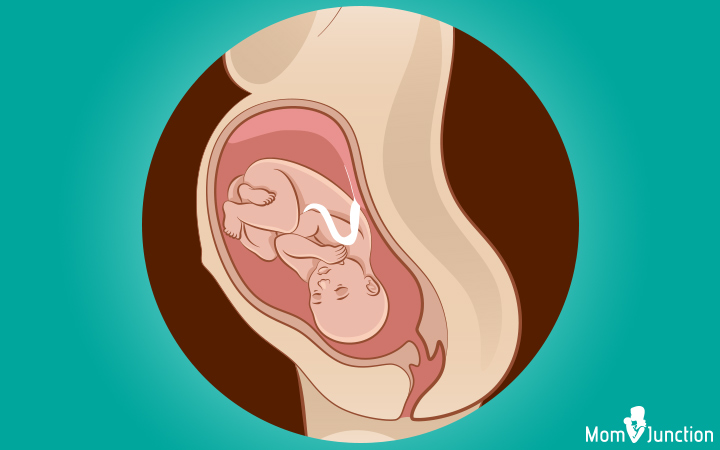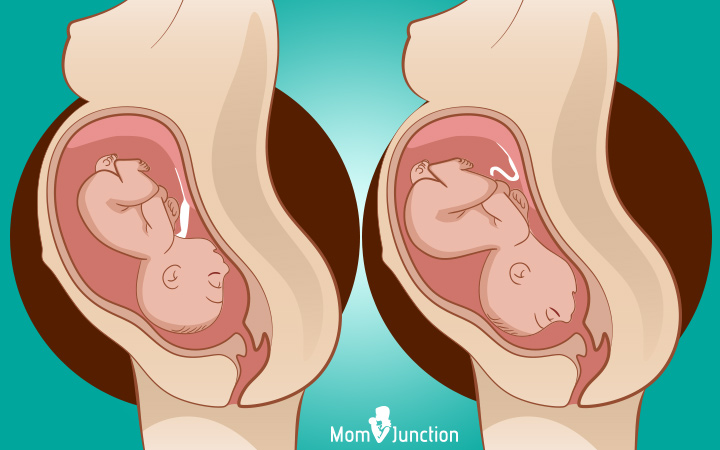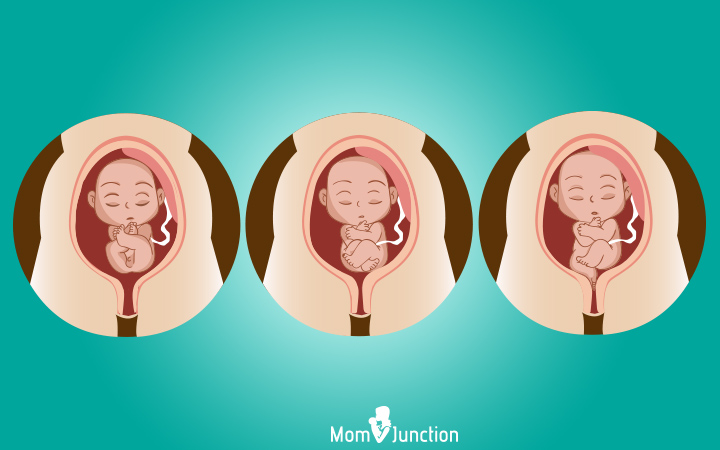Mom Gives Birth to Baby Without a Face
- Why is the fetal position important?
- What are the different fetal positions during pregnancy?
- What are the take chances factors for having a hard fetal position?
- Can the fetal position be corrected?
- How is belly mapping done?
- What are the other ways to know the position of the baby?
Why Is The Fetal Position Important?
The fetal position can make up one's mind the ease or difficulty of your childbirth. Your infant may assume one of various possible baby birth positions by the end of the gestation period, which is also a deciding gene for a vaginal birth or cesarean delivery.
If your babe has shifted to a head-first position by the cease of the term, they tin can descend through your vaginal opening without difficulty during commitment. However, if your baby doesn't movement to a feasible position, your OB/GYN may make up one's mind on an culling commitment method.
This mail service discusses the various fetal positions your baby may nowadays in when yous're in labor and its bear upon on the delivery process.
Dissimilar Fetal Positions During Pregnancy
Before the due date, your baby will drop down into the pelvis. Here are the different positions your baby can get into when you are preparing for your delivery.
ane. Occiput inductive (OA)
This is the platonic position your babe could attain towards commitment. The baby moves into the pelvis with her head-down, facing the mother's back with chin tucked to the breast. Her head points towards the birthing canal. This is called the longitudinal lie.
Termed the vertex presentation of the fetus, this position is mostly attained between 32nd and 36th weeks of gestation (one). The baby will stay in the same position for the residual of your pregnancy. This position is considered ideal for the baby to come out of the birthing canal with caput first.
In that location are two more presentations in the OA position:
i. Face up and brow presentation: (2) The baby will remain in the OA position, but her face and not head volition exist pointing towards the nascency canal. This happens when her chin is pointing outward instead of beingness tucked against the chest. The doctor can identify this position during a vaginal examination, past feeling the bony jaws and the mouth of the baby.
In brow presentation, the baby volition exist in the OA position but her brow will be pointing towards the nascency culvert. During the vaginal examination, the doctor tin feel the anterior fontanelle and the orbits of the forehead.
ii. Chemical compound presentation: The baby is positioned anteriorly with one of her arms lying along her head pointing towards the birthing canal. The arms may slide back during the delivering process, but when they don't, then extra intendance needs to be taken while taking out the baby safely.
[ Read: What Is Occiput Posterior? ]
2. Occiput posterior (OP)
The baby moves into the pelvis with her caput-downwards but facing the front/abdomen of the mother. This position is also known as 'sunny-side upwardly' or 'confront' position. OA and OP are called the cephalic or caput-first positions.
Mostly, around 10-34% of babies remain in OP position during the first stage of labor and so turn to the optimal (OA) position. But, some remain in this position, which can brand labor difficult, resulting in emergency C-section.
This fetal position can prolong your labor, pb to instrumental interventions, severe perineal tears or a C-section (three).
3. Occiput transverse (OT)
The baby lies sideways in the womb. If she fails to plow to the optimal position at the fourth dimension of delivery, then a C-section becomes necessary. During the vaginal examination, the medico can sometimes feel the shoulder, or the arm, elbow or paw prolapsing into the vagina. This position also poses the chance of umbilical cord prolapse, in which the umbilical cord comes out before the baby. Almost 1% of babies in the transverse position can have a cord prolapse (iv), which is a medical emergency and needs an immediate C-section.
In some cases, assisted commitment is carried out by rotating the babe manually or using forceps or vacuum to plough the baby into the platonic position.
four. Breech position
The baby is positioned with her head upward and buttocks pointing towards the birthing canal. This occurs in one out of 25 full-term deliveries. There are 3 dissimilar variations of breech presentations:
i. Complete breech: The buttocks point towards the birthing culvert with the legs folded at the knees and the anxiety positioned near the buttocks. This position increases the adventure of umbilical cord loop in a vaginal delivery. Moreover, the string could pass through the neck before the caput, causing injuries to the babe.
ii. Frank breech: The buttocks signal towards the nascency canal with the legs stretching straight up and feet reaching the head. This can also pb to umbilical cord loop, causing injuries to the baby while attempting a vaginal birth.
iii. Footling breech: The baby'southward buttocks are downwards, with one of her feet pointing towards the birthing canal. This can crusade an umbilical cord prolapse that could even cut off the claret supply and oxygen to the fetus.
v. Umbilical cord presentation
During this, the umbilical cord comes out first through the birthing canal (5). However, there is a difference between umbilical cord presentation and prolapse based on the condition of the uterine membrane.
Whereas a cord presentation happens when the umbilical cord enters the birthing canal before the water breaks, a cord prolapse occurs subsequently the water breaks, which calls for an firsthand C-department.
The positions are influenced past the health condition of the mother and the baby.
[ Read: Stages Of Childbirth ]
What Are The Risk Factors For Having A Difficult Fetal Position?
The below factors increase the hazard of fetal malpositions (six):
Maternal factors:
- In high parity women, who had more five pregnancies of less than twenty weeks gestations (7), the intestinal wall musculus tone fails to concur the babe in a stable longitudinal lie.
- Placenta previa, where the placenta blocks the cervical opening.
- Placenta contracture occurs when the stretchy tissues are replaced by non-stretchy tissues.
- Pelvic tumors such every bit an ovarian cyst or a tumor in the uterus.
- Uterine malformations like uterus cordiformis, subseptus, or septus and uterus unicornis, bicornis, and didelphys tin can cause space brake within the uterus.
- Distended urinary bladder.
Fetal factors:
- Polyhydramnios – backlog amniotic fluid in the birth sac — helps the fetus motion freely in the womb, making information technology unstable and resulting in its malpositioning.
- Oligohydramnios – the deficiency of amniotic fluid — restricts the fetal movements.
- If the mother is carrying multiple fetuses, one or both the fetuses might change their position ofttimes, leading to malpositioning.
- Fetal abnormalities, such as hydrocephaly (tumors of the fetal neck or sacrum), fetal abdominal distention as with hydrops fetalis, and fetal neuromuscular dysfunction, can forbid the fetus from engaging properly into the maternal pelvis.
These factors increase the likelihood of having an unsuitable fetal position but yous don't have to lose promise.
[ Read: Contractions During Pregnancy ]
Can The Fetal Position Exist Corrected?
Yes. There are two ways to correct the position of your baby. They are described beneath:
1. External cephalic version (ECV)
This medical procedure is undertaken later on 37 weeks of pregnancy. The technique involves rotating the babe by applying pressure on the abdomen. The doctor places one manus over the head of the infant and the other hand on the buttocks to turn her to the optimal position.
During this procedure, the heartbeat of the baby will exist closely monitored using an ultrasound. In the case of whatsoever discrepancy in the fetal heart rate, the procedure will be stopped immediately.
This procedure may or may non work. Studies testify that about ane in 1,000 women goes into labor subsequently an ECV while about 1 in 200 women demand an immediate C-section (8).
ECV is not recommended in the case of:
- Multiple pregnancies
- Unusual shape of uterus
- Recent vaginal bleeding
- Low levels of amniotic fluid
- Placenta previa
- Complicated pregnancy
ii. During labor
Most babies turn to an ideal birthing position with the onset of labor. If it doesn't happen, if the baby doesn't engage during labor, or if the shape of the pelvis is non favorable for vaginal birthing, then a Cesarean-department is performed.
[ Read: How To Ease False Labor ]
How Is Belly Mapping Done?
Belly mapping is a method for you to track the position of your baby. Y'all can practice this from the eighth month of pregnancy. Nevertheless, make sure to talk to your doctor before doing information technology.
Things you require: A marker (the ink stain should exist piece of cake to remove)
How to do:
- Lie down, draw a circle on your tummy and dissever information technology into 4 parts.
- Experience the movements of the infant. Endeavor to experience the babe'south head by slightly putting force per unit area on your abdomen. The indicate where you lot feel a ball like feature, marking information technology as the head on your belly.
- Use a fetoscope to hear your baby's heartbeat and mark the point. You will feel a long hard mass, which indicates the back of your baby. The eye is the function of this long mass.
- Next, attempt to find the bum, which feels like a hard part. Mark this point on your belly.
- At present feel the kicks and wiggles every bit they give you a clue well-nigh the location of the baby's legs and knees. Marking it also.
- Bring together all the points you have marked to find the position of your baby.
Abdomen mapping is complicated, and you may or may not be able to track the infant'southward movements accurately. Therefore, you lot may club it with a few other ways.
Other Ways To Know The Position Of The Infant
Hither are a few indications:
[ Read: Exercises For Normal Delivery ]
| Indications | Likely fetal position |
|---|---|
| Feel the baby's kicks under the ribs with your navel popping out | Anterior position with head-downward |
| Feel the kicks at the front of the breadbasket and the tummy seems flattened | Posterior position |
| Push button the lump on your bump and experience the whole baby moving | The lump is the bottom of the baby. Determine the position based on the location of that lump |
| Lump on ane side that moves by itself without any change in the positioning of the rest of the body | The lump is the caput of your baby. You can decide the position based on the position of the lump |
| Feel the hiccups at the bottom of the belly | Head-downwardly position |
| Feel the hiccups higher up the abdomen button | Head-upward position |
| Extreme hurting under the ribs | Head-upward position |
| Heartbeats felt to a higher place bellybutton | Head-upwards |
| Heartbeats felt beneath belly push | Head-downwards |
These are but an assumption and a style to get connected with the baby. They practice not replace your doctor's communication.
[ Read: Baby Crowning ]
The fetal positioning is important during pregnancy and labor, as it decides how your labor will proceed. Though the babies move into various positions, at the time of labor, they might movement into the optimal position. If they don't, then C-section is the all-time selection for delivery.
Practise you accept anything to say on this? Share with united states of america in the comment department below.
Recommended Manufactures:
- When Is Your Infant Likely To Drop?
- Signs Of Labor And What To Do
- Bradley Method Of Childbirth
- How To Speed Upward Labor
The following two tabs change content below.
- Reviewer
- Writer

Dr. Sangeeta Agrawal worked in Royal London, St. Bartholomew's, North Middlesex and Barnet Full general hospitals in London. Currently, she runs her own dispensary in Mumbai. She is also attached to Bhatia Infirmary, Breach Candy Hospital, Wockhardt Hospital, and Global Hospital. Her areas of expertise include obstetrics and gynecology, involving teenage care, antenatal, intrapartum, mail service-natal care, painless labor, fertility control, menopause... more

Shreeja holds a postgraduate degree in Chemical science and diploma in Drug Regulatory Diplomacy. Earlier joining MomJunction, she worked every bit a inquiry analyst with a leading multinational pharmaceutical company. Her interest in the field of medical enquiry has developed her passion for writing research-based articles. As a writer, she aims at providing informative articles on health and pharma, especially related to... more
Source: https://www.momjunction.com/articles/position-baby-important-pregnancy_0078625/





0 Response to "Mom Gives Birth to Baby Without a Face"
Post a Comment